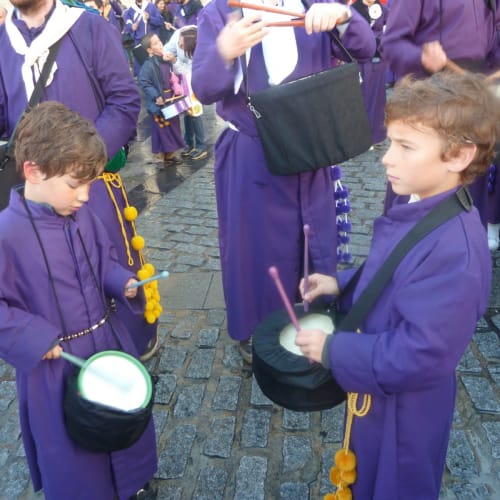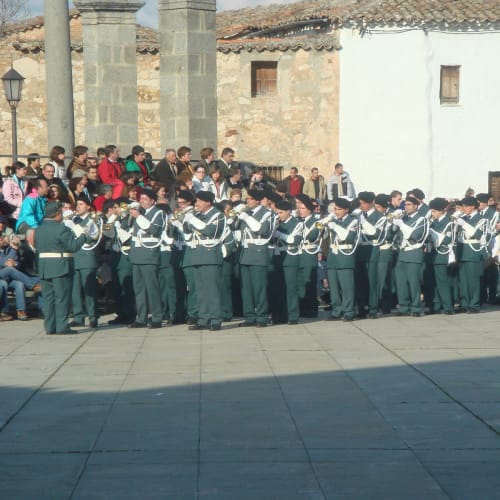Brotherhood of Drummers
Don Harris | June 2011




The roll of more than a hundred drummers disturbed the calm of the misty early hours of Good Friday. Ruth and I were standing in the Plaza Mayor of the hilltop city of Cuenca looking through the Roman arch and straining to see the heavy mahogany platform that inched its way up the narrow cobblestoned street. Mounted on it was a meticulously carved likeness of Jesus carrying his cross to Calvary.
The celebration of Semana Santa, Holy Week, is a signature event throughout Spain. The emotional observance in Sevilla, with bystanders spontaneously bursting into mournful song, is world famous. In the north, Zamora is a favorite of the devout for the solemnity of its observances. Neighboring Valladolid has perhaps the finest examples of exquisitely carved life-size figures, many dating from the seventeenth century.

I don't think you need to be a believer, or even personally religious at all, to experience the amazing amount of devotion and community involvement which occurs in many cities and towns in Spain each Easter season. Ruth and I have made it a point to be a part of Semana Santa in various parts of Spain, both in the north and the south. We have even visited a tiny village where they reenact Jesus’ descent from the cross and burial.
Yet, whenever Spaniards get together there is always a human element that trumps any possibility of precision. In the hamlet, people stopped to enjoy some sizzling churros as they observed the procession to the burial place of Jesus. In Zamora, the brotherhoods paused half-way through their five hour processing for a bocadillo sandwich break with family before assuming the penitential burden once more.
Even though Ruth and I have spent over forty-five years exploring just about every nook and cranny of Spain, there are always some experiences we cannot fully anticipate. Semana Santa in Cuenca was just that sort of circumstance. The setting is an ancient hilltop village city dramatically perched above a gorge at an altitude of 3,200 feet. The goal of the men bearing the paso was to pass through the ancient Roman gate into the broad Plaza Mayor which stretches out in front of the 12th century cathedral named Our Lady of Grace. Even under normal circumstances, the carrying of the paso is no mean feat. The men can only go a few yards before they have to stop and gather their strength. This particular street is on a steep incline, and the cobblestone plaza itself is at a slant.
Beneath the platform, or paso, were 30 or 40 men, shouldering the several tons of weight of the life-size image of Jesus and his cross, mounted on the heavy timbers. The men are members of a Hermandad, who consider it an honor each year to bear this heavy burden with their brothers as the procession winds its way through the city for several hours during the pre-dawn hours.
This particular procession making its way with arduous effort was one of nine that the townspeople launched throughout the week. On previous nights and days, the events contributing to Christ's passion were graphically presented on the pasos borne by other brotherhoods: the temptation in the garden, the traitorous kiss of Judas, the denial of Peter, the sorrowful mother, the scourging and many other events that resemble what some of you may know as the ‘stations of the cross.’ The pasos were accompanied by long files of penitentes dressed identically in robes and peaked hoods, and were preceded by musicians playing band instruments.
As the paso approached the gate, the sound of hundreds of drums reverberated, with one group of youths playing one pattern and another responding. The young drummers and their friends had stayed up all night awaiting this moment. As the paso entered the plaza the crowd started shouting at the figure of Jesus carrying his cross. In a stylized way they were imitating the mocking which Jesus must have felt. After rolls of their drums, the drummers would raise their wooden drumsticks in the air, clacking them together and then forming a cross as they raised them over their heads.
I wove myself into the crowd of young people who were interspersed among families and their umbrellas. It was almost surreal to see the little children amusing themselves in the gathering while others were part of this profound drama. This was not a carefully orchestrated tourist event that was unfolding; it was the expression of people who have replicated this experience every year of their lives. Ruth and I have been to many Semana Santa celebrations, but the memory of Holy Week in Cuenca is one we will keep for a long time.

Another of the surprises, which we had not anticipated, when making plans for Cuenca, is that concurrent with Semana Santa is the Semana de Musica Religiosa, a week of religious music. It is a gathering of musicians in Cuenca, which has been going on for fifty years. Each afternoon or early evening during the week, we had the option of experiencing sublime music in a perfect preparation for the processions.
Tuesday evening we were treated to Benedictine chants performed by choirboys from the Benedictine Abbey of Santa Cruz del Valle de los Caidos. Their director was a monk who had trained at the Abbey of Santo Domingo de Silos, 50 years ago. (Some of you may remember the popular CD called Chant, issued in 1994, which came from that monastery.) Some of the boys, after they matured into young men, continued their devotion to church music by forming a group called Schola Antiqua. On Thursday, they sang the service of Tenebrae in the 13th Century Iglesia de San Miguel.
But for me, one of the best musical experiences I have ever had, occurred in another church, San Felipe Neri. Ruth and I and our friends just happened to stumble upon it during our noonday walk. There seven young women from the Netherlands sang medieval chants and hymns from the sisterhood of the Beguines in Bruges. The acoustics in the church of San Felipe Neri were bright and alive. As I sat at the end of a row of pews, I was enveloped by the pure clarity and beauty of the voices of these lovely women as they processed by.
Someone pointed out to me, that when things seem to be declining, to be behind is to be ahead! That is how I felt during our week in Cuenca. I did not know or care what kind of turmoil that city had experienced through the centuries. At this isolated moment, I was apart from all the rough and tumble of our emerging age. I experienced the essential harmony of sublime voices, and that of a community of Spaniards who face an uncertain future, but who nonetheless maintain a tradition of timeless devotion.
For those of you who might think about visiting Cuenca during Semana Santa, it is a low season airfare and just a short drive from the Barajas Madrid airport. I will post our itinerary from this year, 2011.
Tu amigo,
Don

